|
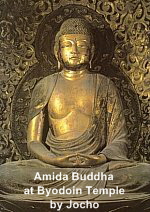  Jōchō 定朝 (Jocho). It is impossible to exaggerate the importance of Jōchō 定朝 (d. +1057) to the world of Japanese Buddhist statuary. From his loins and workshop sprang three of the most important schools of Japanese Buddhist statuary -- the Enpa 円派, Inpa 院派, and Keiha 慶派 schools, which dominated Buddhist sculpture thereafter. Jōchō 定朝 (Jocho). It is impossible to exaggerate the importance of Jōchō 定朝 (d. +1057) to the world of Japanese Buddhist statuary. From his loins and workshop sprang three of the most important schools of Japanese Buddhist statuary -- the Enpa 円派, Inpa 院派, and Keiha 慶派 schools, which dominated Buddhist sculpture thereafter.
Today he remains the undisputed patriarch of Japan’s “independent” style of religious statuary, called Wayō 和様 (lit. Japanese Style). After Jōchō’s death, numerous linage charts or genealogy tables (Busshi Keizu 仏師系図) were made to trace his line. But these charts are frought will difficulty, for they typically include Jōchō’s direct descendants, pupils, and adopted sons without differenciation. See below lineage chart for the generally accepted version.
Jōchō - Father of Three
Schools of Buddhist Statuary
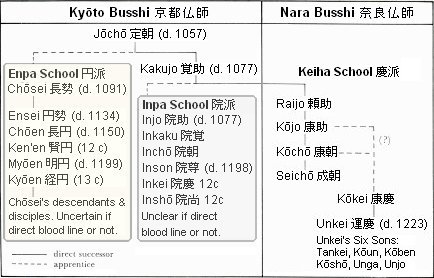
|
Note: Mori Hisashi, author of Sculpture of the Kamakura Period (ISBN 0-8348-1017-4), says the Enpa Line, from Chōsei through Myōen, are direct descendants; and the Inpa Line, from Injo through Inson, are also direct descendants. The above chart is based in part on one appearing in Mori’s book.
|
|

INTRO: Jōchō, Enpa, Inpa, and Keiha Schools
For Historical Setting, Please See Heian Era Page. Jōchō’s statuary workshop in Kyoto 京都, along with Jōchō’s descendents and pupils, gave birth to the two most important Bussho 仏所 (independent statue workshops) of the 11th and 12th centuries -- the Enpa School 円派 and Inpa School 院派. The two are known collectively as the Kyoto Busshi 京都仏師, for their main workshops were based in Kyoto. The two dominated statue-making during the last half of the Heian 平安 Period (also known as the Fujiwara 藤原 period). Their refined, classical, and elegant styles appealed to the tastes of the court, nobility, and major temples. The third most important workshop, which achieved dominance in the subsequent Kamakura Period (+1185-1332), also sprang from Jōchō’s workshop. It is known as the Keiha School 慶派, and its main studio was located at Kofukuji Temple (Kōfukuji 興福寺) in Nara. Hence its artists were known as the Nara Busshi or Nanto Busshi. Although these three schools were rivals, there was nonetheless collaboration among them. These three, together with the Tori School of the Asuka period (+538-645), represent Japan’s main schools/styles of Buddhist sculpture. A fifth school of statuary, known as the Zenpa School 善派, appeared in the Kamakura period as well, further eroding the influence of the Enpa and Inpa schools of Kyoto.

Jōchō, His Father Kōshō 康尚, Statue Workshop in Kyoto
Jōchō grew up in Kyoto and worked at his father’s statue workshop. The government-run workshops (Zobussho 造仏所) of the Nara period (+710-794) had long since closed down and been replaced by independent workshops and temple-run studios known as Bussho 仏所. Each workshop/studio was under the direction of a master sculptor (Daibusshi 大仏師), a hereditary position. Jōchō thus inherited the workshop of his father, Kōshō 康尚 (Kosho) and served thereafter as its leader. Jōchō’s studio created elegant and refined pieces that appealed greatly to the court and nobility. Extant statues reflecting his style are known today as Jōchōyō 定朝様 (Jochoyo), meaning literally “in the style of Jōchō”). During his lifetime, Jōchō was the first-ever layman artist to achieve the rank of Hokkyō 法橋 (Hokkyo), a lofty title previously awarded only to top-level Buddhist monks. Although based in Kyoto, Jōchō was associated with temples in other areas as well. For example, he was involved in a restoration project for Kōfukuji Temple 興福寺 (Kofukuji) in Nara -- the temple later became the main workshop for the Keiha 慶派 School, the dominant school of Buddhist statuary in the Kamakura period (13th-14th centuries), and one that sprang from Jōchō’s own lineage.
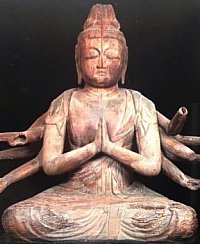  Kōshō 康尚 (Kosho), Father of Jōchō Kōshō 康尚 (Kosho), Father of Jōchō
Jōchō inherited the workshop of his father, Kōshō 康尚 (Kosho), and served thereafter as its leader.
PHOTO: Statue of the 1,000-Armed Kannon Bosatsu 千手観音坐像 attributed to Kōshō. Located at Kōryūji Temple 広隆寺 (Koryuji), Kyoto. Wood, Mid-Heian Era.
According to the temple, the cracked head of this statue was in their collection for many years, but the body was presumed lost. However, in +1911, the body was discovered (for unknown reasons) inside an old two-storied gate on temple grounds. Only 13 of the customary 42 arms remain, and the wood is discolored and much damaged. Made in the Yoseki Zukuri style 寄木造り (jointed block technique, assembled wood method) which came to prominence around the middle of the Heian era (+794-1185).
Jōchō’s Only Surviving Artwork. Most of Jōchō’s artwork did not survive the passage of time. Fortunately, however, one great monument to Jōchō’s artistic genius is still extant -- the outstanding Bosatsu on Clouds and Amida statue at Byōdōin Temple 平等院 (Byodo-in, Byodoin) in Kyoto. The Amida statue is attributed to Jōchō himself. This large-scale extant installation of 50-plus Buddhist statues, completed in +1053, provides many examples of Jōchō’s talent and his widespread adoption of the relatively new statue-making techniques known as Warihagi 割矧 (split-and-join method) and Yosegi Zukuri 寄木造 (assembled-wood method). These techniques allowed Jōchō and his team to plan the entire production process before work even began. These techniques achieved prominence in subsequent decades, for they allowed for systematized mass production and the creation of very large statues. Indeed, Jōchō is credited with perfecting both techniques. See Materials and Techniques for Making Buddha Statues for much more on this topic. The Byōdōin installation was designated a Japanese National Treasure in 1904 and is considered by most as a prime example of Japan's flowering indigenous artistic genius.

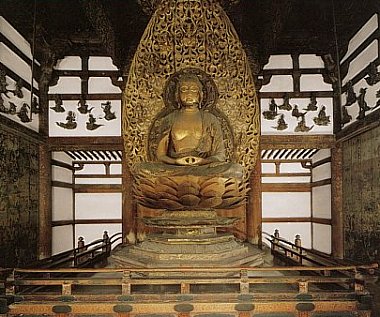
Amida Buddha surrounded by 52 Bosatsu on Clouds.
Amida Hall (aka Phoenix Hall), Byōdōin Temple 平等院, Kyoto.
Made around +1053 by Jōchō & His Team. The central Amida
statue is attributed to Jōchō. Photo courtesy temple catalog.
Learn more and view additional photos here

Japanese Style Sculpture -- Wayō. Says JAANUS about the Byōdōin Temple’s Amida statue: “The Amida Nyoraizō 阿弥陀如来像 (+1053) at Byōdōin Hō-ō-dō 平等院鳳凰堂 Kyoto (wood and gold-leaf). The figure is seated cross-legged with the knees wide and low. The chest is flat and broad, and the drapery folds (emon 衣文) are carved in low parallel ridges. The round face has a serene expression known as enmanguzoku 円満具足, meaning ‘fully-rounded and perfect, lacking in nothing’ and was thought to represent a state of complete enlightenment, and to express the ’true form of Buddha’ (Hotoke-no-Honyō 仏の本様). Admired for its simplicity and gentle quality, Jōchō's work was regarded as the perfect representation of Wayō 和様 (Wayo, lit. Japanese style), as distinct from Chinese-style images. <end JAANUS quote>

Jōchō and His Team of Sculptors. Below Text from Byōdō-in Temple Catalog, Published May 2000 by Byōdō-in Temple. The rich variety of styles and techniques evident in the Bosatsu on Clouds at Byōdōin Temple hints at diversity among the sculptors who created them. Sometime before the establishment of the Phoenix Hall in +1053, the Heian-period statesman Minamoto-no-Tsuneyori mentioned in his diary (Sakeiki) that Jōchō was carving 27 Buddhist images as offerings for childbirth by Empress Ishi, wife of Emperor Goichijo. At the time, around +1026, Jōchō had 20 master sculptors working under him. He and each of the master sculptors had five lesser sculptors working under their direction. Jōchō thus appears to have had a large organization of Buddhist sculptors at his disposal. It can be supposed that by the time work began on the Bosatsu on Clouds at Byōdōin Temple, this organization had evolved considerably. Yet, the variety of styles and techniques evident in these statues suggests they were the outcome of each master's personal touch, and that we cannot suppose Jōchō's authority restricted individual creativity. This may be the origin of the captivating attraction of the Bosatsu on Clouds. <end quote>
Says the Same Byōdōin Catalog: Jōchō is credited with many of the Buddhist statues at Hōjōji (Hojoji) Temple 法成寺 in Kyoto as well. Hōjōji Temple was founded in +1020 by Fujiwara-no-Michinaga, the father of Fujiwara-no-Yorimichi, but it is no longer standing -- it was lost around the 14th century. For his work at Hōjōji (around +1022), Jōchō became the first Buddhist sculptor to receive the distinguished Buddhist title and rank of Hokkyō 法橋 (Hokkyo). <end quote>

Bugakumen 舞楽面 are masks used in various performances of Bugaku 舞楽, or imperial Japanese court dances. Extant masks are typically unsigned, and thus little is known about who created them. However, after examining extant masks that retain the maker’s inscription, it is generally assumed most masks were made by professional Buddhist sculptors (Busshi 仏師) such as Jōchō and Unkei 運慶 (d. +1223). Editor’s Note: Need to find, if possible, extant masks by Jōchō and / or Unkei.
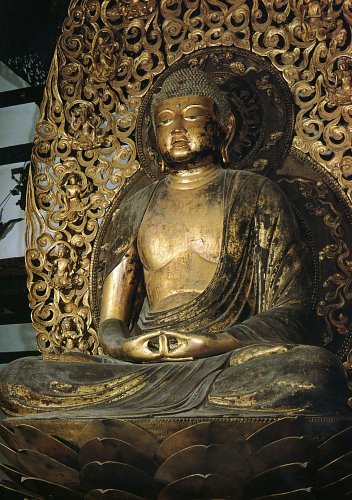
Amida Nyorai 阿弥陀如来像. Made by Jōchō around +1053
The only extant piece attributed to Jōchō in Japan.
Byōdōin Temple 平等院, Kyoto. Photo from temple catalog.

RESOURCES
- JAANUS. Japanese Architecture & Art Net Users System. Online database devoted to Japanese art history. Compiled by the late Dr. Mary Neighbour Parent, it covers both Buddhist and Shintō deities in great detail and contains over 8,000 entries.
- Dr. Gabi Greve. See her page on Japanese Busshi. Gabi-san did most of the research and writing for the Edo Period through the Modern era. She is a regular site contributor, and maintains numerous informative web sites on topics from Haiku to Daruma. Many thanks Gabi-san !!!!
- Heibonsha, Sculpture of the Kamakura Period. By Hisashi Mori, from the Heibonsha Survey of Japanese Art. Published jointly by Heibonsha (Tokyo) & John Weatherhill Inc. A book close to my heart, this publication devotes much time to the artists who created the sculptural treasures of the Kamakura era, including Unkei, Tankei, Kokei, Kaikei, and many more. Highly recommended. 1st Edition 1974. ISBN 0-8348-1017-4. Buy at Amazon
 . .
- Classic Buddhist Sculpture: The Tempyo Period. By author Jiro Sugiyama, translated by Samuel Crowell Morse. Published in 1982 by Kodansha International. 230 pages and 170 photos. English text devoted to Japan’s Asuka through Early Heian periods and the development of Buddhist sculpture during that time. ISBN-10: 0870115294. Buy at Amazon.

- The Great Age of Japanese Buddhist Sculpture, AD 600-1300. By Nishikawa Kyotaro and Emily J Sano, Kimbell Art Museum (Fort Worth) and Japan House Gallery, 1982. 50+ photos and a wonderfully written overview of each period. Includes handy section on techniques used to make the statues. The Great Age of Japanese Buddhist Sculpture (AD 300 - 1300)
 . .
- Comprehensive Dictionary of Japan's National Treasures. 国宝大事典 (西川 杏太郎). Published by Kodansha Ltd. 1985. 404 pages, hardcover, over 300 photos, mostly color, many full-page spreads. Japanese Language Only. ISBN 4-06-187822-0.
- Bosatsu on Clouds, Byōdō-in Temple. Catalog, May 2000. Published by Byōdō-in Temple. Produced by Askaen Inc. and Nissha Printing Co. Ltd. 56 pages, Japanese language (with small English essay). Over 50 photos, both color, B&W. Some photos at this site were scanned from this book. Of particular use when studying the life and work of Jōchō Busshi.
- Visions of the Pure Land: Treasures of Byōdō-in Temple. Catalog, 2000. Published by Asahi Shimbun. Artwork from Byōdō-in Temple. 228 pages, Japanese language with English index of works. Over 100 photos, color and B&W. Some photos at this site were scanned from this book. No longer in print. Of particular use when studying the life and work of Jōchō Busshi.
- Numerous Japanese-language temple and museum catalogs, magazines, books, and web sites. See Japanese Bibliography for extended list. Also relied on Hōryūji Temple 法隆寺 (Horyuji) catalogs and Asuka Historical Museum.

  JAPANESE WEB SITES JAPANESE WEB SITES
|